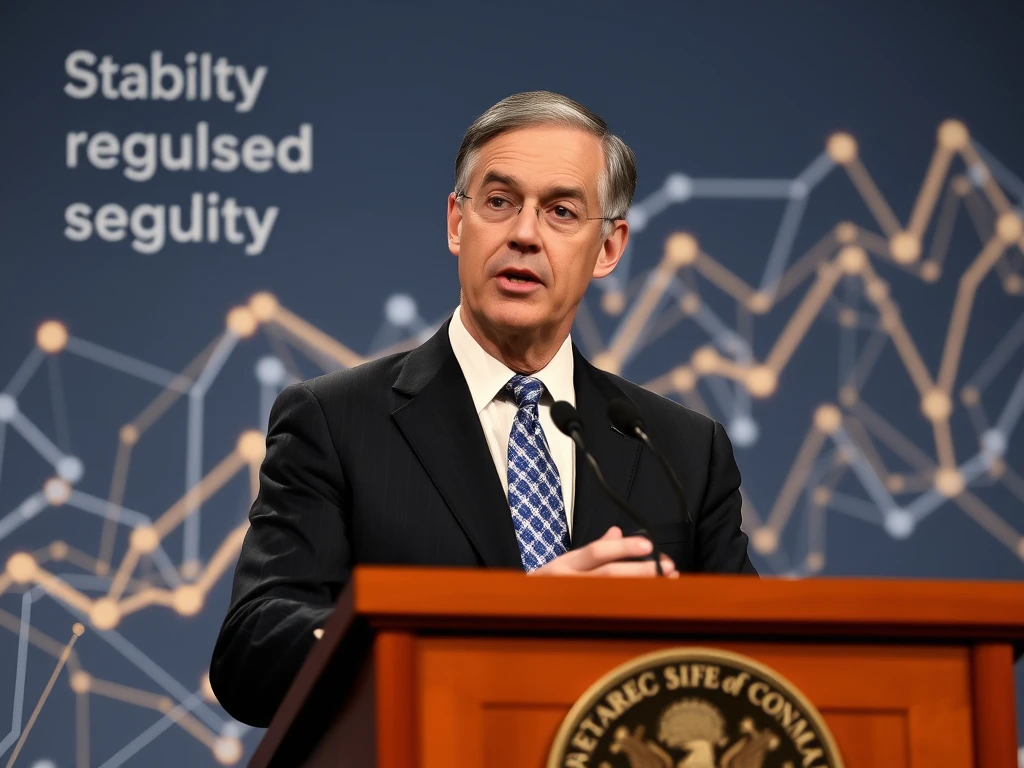Crucial Support: Fed’s Powell Champions Stablecoin Legislation for Crypto Mainstreaming

Exciting developments are unfolding in the crypto world as Federal Reserve Chair Jerome Powell doubles down on his advocacy for stablecoin legislation. This renewed push signals a potentially transformative phase for digital assets in the United States. Are we on the cusp of seeing comprehensive regulations that could unlock mainstream cryptocurrency adoption? Let’s delve into Powell’s recent remarks and what they could mean for the future of crypto.
Why is Stablecoin Legislation a Top Priority for Fed Powell?
In a recent address at the Economic Club of Chicago, Powell emphasized the growing relevance of digital assets and the necessity for a clear legal framework, especially for stablecoins. He highlighted that stablecoins, designed to maintain a stable value, possess the characteristic of a “digital product” with the potential for “fairly wide appeal.” This appeal, however, comes with a caveat: the imperative need for robust consumer protections. Powell’s stance is rooted in the belief that as cryptocurrencies become more integrated into the financial mainstream, establishing guardrails is not just beneficial, but essential.
Here’s a breakdown of Powell’s key points:
- Mainstream Adoption on the Horizon: Powell acknowledges the shift towards greater acceptance of digital assets, indicating a maturing crypto landscape.
- Consumer Protection is Paramount: He stresses that any regulatory framework must prioritize safeguarding consumers within the digital asset ecosystem.
- Learning from Past Setbacks: Referencing the “wave of failures and frauds” in the crypto space, Powell underscores the urgency of preemptive regulation to prevent future crises.
- A “Good Idea” Whose Time Has Come: Powell explicitly states that creating a legal framework for stablecoins is a “good idea” and a necessary step forward.
The Rocky Road to Cryptocurrency Regulation: Past and Present
Powell didn’t shy away from recalling past challenges in achieving cryptocurrency regulation. He noted the Fed’s previous attempts to collaborate with Congress on stablecoin legislation, particularly during the tumultuous crypto years of 2022 and 2023. These efforts, unfortunately, “were not successful.” However, the landscape is shifting. Powell perceives a change in climate, with a renewed focus from Congress on establishing a legal framework. This renewed interest, according to Powell, is fueled by the increasing “mainstreaming of that whole sector.”
What Makes Stablecoins So Important in Digital Assets?
Stablecoins are not just another type of cryptocurrency; they play a unique and vital role within the digital asset ecosystem. Their peg to fiat currencies, like the US dollar, provides a crucial element of stability in the often-volatile crypto market. This stability makes them incredibly useful for:
- Remittances: Facilitating faster and potentially cheaper international money transfers.
- Cryptocurrency Trading: Serving as a safe haven asset and a bridge between fiat and other cryptocurrencies, enabling seamless trading pairs.
The numbers speak for themselves. The total value of all stablecoins currently sits at a staggering $227 billion. Dominating this market are dollar-pegged giants USDC and USDT, commanding over 88% of the total market share. This dominance underscores the critical role of dollar-backed stablecoins in the current crypto landscape and the urgency for clear stablecoin legislation.
Political Winds Favoring Digital Asset Regulation
The political landscape in Washington D.C. is also showing signs of becoming more receptive to digital assets. The current administration, under President Trump, is perceived as more pro-crypto, marked by appointments and policy shifts aimed at positioning the US as a leader in the digital asset space. A key development is the establishment of the President’s Council of Advisers on Digital Assets, helmed by Bo Hines. Hines has publicly stated that a comprehensive stablecoin bill is a top priority.
Adding to this momentum, the Senate Banking Committee’s progress with the GENIUS Act suggests that a final cryptocurrency regulation bill, specifically targeting stablecoins, could be presented to the President imminently. Hines even suggested a timeline of “in the next two months.” This potential swift action highlights a growing consensus and urgency in Washington to address the regulatory gaps in the digital asset sector.
The Path Forward for Stablecoin Legislation and Mainstream Adoption
Jerome Powell’s renewed advocacy for stablecoin legislation is a significant signal. It indicates that despite past setbacks, the conversation around cryptocurrency regulation is not only alive but gaining momentum. For the crypto industry, this could be a pivotal moment. Clear, well-defined regulations for stablecoins could:
- Boost Investor Confidence: Providing a regulated environment can attract more institutional and retail investors who have been hesitant due to regulatory uncertainty.
- Foster Innovation: Clarity in regulation can encourage responsible innovation within the stablecoin sector and the broader crypto space.
- Enhance Consumer Protection: Robust frameworks can safeguard users from potential risks associated with stablecoins, fostering trust and wider adoption.
- Solidify US Leadership: Proactive regulation can position the United States as a leader in the responsible development and adoption of digital assets.
While the specifics of any upcoming legislation remain to be seen, Powell’s consistent voice in favor of cryptocurrency regulation, particularly for stablecoins, is a powerful catalyst. As the industry navigates this evolving landscape, the coming months could be decisive in shaping the future of digital assets and their integration into the global financial system.
Conclusion: A Pivotal Moment for Stablecoins and Crypto
Fed Chair Powell’s reasserted support for stablecoin legislation marks a potentially transformative moment for the cryptocurrency industry. His emphasis on consumer protection and the mainstream appeal of stablecoins, coupled with growing political will, suggests that comprehensive regulations might be closer than ever. As we watch for developments in Washington, one thing is clear: the push for clear and effective stablecoin legislation is gaining strength, and its successful implementation could be a game-changer for the future of digital assets and their widespread adoption.







